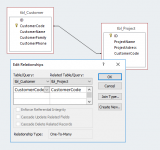Hello everyone,
For limitaion of access database which is 2 Gb, I splited backed database to two backend, but relationships between them has gone and Cascade option are disables.
I also know I can use SQLServer databse instead of Access database, but for some reasons I have to perform it by Access DB.
What's your idea ? Actually Cascade Delete and Cascade Update are very important in my program.
For limitaion of access database which is 2 Gb, I splited backed database to two backend, but relationships between them has gone and Cascade option are disables.
I also know I can use SQLServer databse instead of Access database, but for some reasons I have to perform it by Access DB.
What's your idea ? Actually Cascade Delete and Cascade Update are very important in my program.

